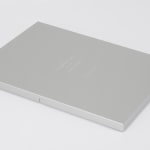-
Artworks







The Temptation of the Diagram, 2017
Signed accordion print in a signed colophon folder, 144 page case bound artist’s book, featuring essays by Kenneth Rogers, Frederick Stjernfelt and Matthew Ritchie, and a custom laser engraved, anodized aluminum case.Colophon folder: 24 x 306 in. (61 x 777.2 cm)
Aluminum case: 24 1/4 x 18 1/4 x 1 3/8 in. (61.6 x 46.4 x 3.5 cm)Edition of 55 plus 5 artist's proofs$ 5,000.00Further images
'The Temptation of the Diagram' comprises three elements, a 24' (60.96 cm) x 306' (777.24 cm) signed accordion print in a signed colophon folder, an artist's book featuring essays by...'The Temptation of the Diagram' comprises three elements, a 24" (60.96 cm) x 306" (777.24 cm) signed accordion print in a signed colophon folder, an artist's book featuring essays by Kenneth Rogers, Frederik Stjernfelt and Matthew Ritchie and a laser engraved, anodized aluminum case.
The fully unfolded print is a twenty-five-and a half foot-long paper ‘leporello’, a type of accordion fold named for a character in Mozart’s Don Giovanni.
The dimensions of the leporello correspond to a 1:1 scale transcription of the length and height of a horizontal drawing on mylar, made on the walls of the Getty Research Institute studio while Ritchie was the Artist in Residence there in 2012. The edition’s length is determined by the size of that original drawing, which occupied all the useable walls, becoming itself an index of the site of the Getty studio. In its original installation, the collected source material was installed above and below the time line drawing.
For the edition, the drawing has been remade as an overlay that links 816 specific historical diagrams, selected from the thousands that he collected at the same time, fusing a chronological history of diagrams with an overlay of speculative notation. It is not a history of the diagram, but an art historical thought experiment, an anti-history. The edition may be read or exhibited horizontally or wall-mounted, and may be hung folded to exhibit any number of pages, ranging from a single page to fully extended, using the punched pin-holes provided.
The accompanying book, was written over the next two years and it contains complete documentation of the project, which has also been presented in the form of installations and curated exhibitions. Professor Rogers describes the project in more depth, Matthew Ritchie examines some shared features of diagrammatic relationships, while Professor Stjernfelt provides a glossary of diagrammatic terms.
The Temptation of the Diagram was printed in an edition of fifty five in New York City by Yujin Lee, Raphael Lyon, Nicole Maloof and Lauren Silva for Matthew Ritchie and the Getty Research Institute. There are additionally five artist proofs (AP), five printers proofs (PP), five Hors Commerce (HC) and five museum copies (M), each numbered with Roman numerals I-V.
The edition is printed with Epson Ultrachrome Ink on Hiromi Aya Paper with an accompanying colophon, folder and book designed by Purtill Family Business and printed by Shapco printing in Minneapolis. The edition is signed and numbered on the verso of the last page and on the colophon folder.













